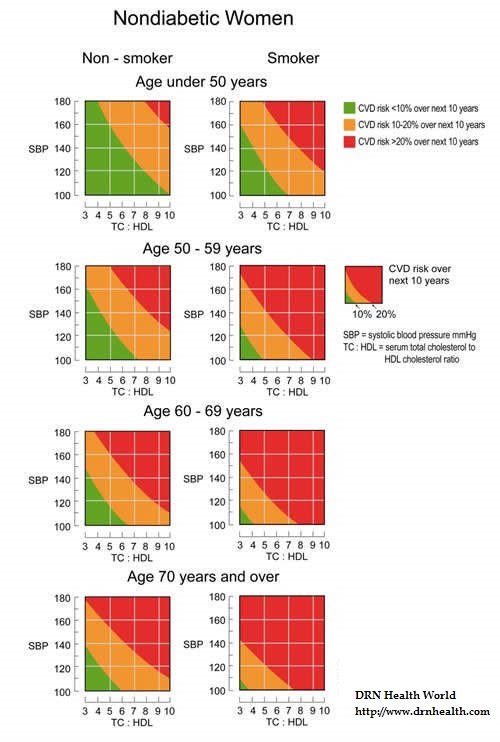Assessment of total cardiovascular disease risk in asymptomatic individuals is important to prevent CVD. People with established cardiovascular disease also are at high risk of developing further vascular event. People with high risk of CVD need the most intense lifestyle modification, and medication as required. Some individuals, who are asymptomatic and apparently healthy, may have a higher CVD risk. Preventive measures of CVD should be recommended according to the total CVD risk level. However, the risk factor management should usually not depend on a single elevated risk factor. It should have a multi-factorial approach.
The American Heart Association, The Joint British societies, and the European Society of Cardiology have highlighted the importance of CVD risk assessment. Therefore, multivariate risk profiles have been developed. These risk profiles help physicians to evaluate the risk of CVD easily and apply preventive measures. These also help physicians to motivate as well as reassure people and choose suitable therapy. The risk profiles lead health-care professionals to identify the cumulative nature of CVD risk factors.
Assessment of 10-year risk of developing CVD
- Select the panel from the CVD risk chart for gender, age, and smoking status.
- Within the particular panel, identify the level of CVD risk from the point where the systolic blood pressure (SBP) and the ratio of the total and HDL-cholesterol meet each other. If HDL-cholesterol level is not available, consider it is 1.0 mmol/L (38.7 mg/dL) and use the lipid level as total cholesterol level.
- Red areas of the panel indicate individuals with highest 10-year CVD risk, which exceeds 20 %. It is roughly equivalent to a 10-year coronary heart disease (CHD) risk of more than 15 %. People with a 10-year CVD risk of greater than 30 % should be managed immediately. Individuals with a CVD risk of more than 20 % should be treated gradually.
- Orange areas indicate people with a moderate 10-year CVD risk (10-20 %).
- Green areas show individuals with a lower 10-year CVD risk (<10 %).
- Smoking status should be considered as positive, if an individual has lifetime exposure to tobacco smoking. People, who have given up tobacco smoking within five years should be considered as positive smoking status.
- These CVD risk profiles depend on untreated levels of cholesterol and blood pressure.
- The initial non-fasting (random) total and HDL cholesterol, and the first blood pressure reading can be used to assess the CVD risk. However, it is recommended to re-assess the risk later to consider using medication.
- These CVD risk profiles are unsuitable for people with:
- Chronic (long-term) kidney disease/chronic renal failure
- Coronary heart disease (CHD) or other atherosclerotic diseases
- Diabetes mellitus
- Familial hypercholesterolaemia
- Inherited dyslipidaemias
- The CVD risk is greater than the predicted value in the risk profile for individuals with:
- Elevated triglyceride levels
- A family history of early onset (premature) stroke or CVD (men aged under 55 years or women aged under 65 years)
- Premature menopause
- Impaired fasting sugar (glucose level between 6.1-6.9 mmol/L or 110-124 mg/dL)
- People, who have a first-degree relative with early onset stroke or CVD, have a 1.5 times higher CVD risk compared to the predicted value. It will be doubled, if they have more than one family member with such a history.
- The risk profiles may overestimate the CVD risk in most people less than 40 years. Therefore, health-care professionals should assess young people clinically in deciding on medication. However, most young people with a higher 10-year CVD risk tend to have high blood pressure, elevated cholesterol, and low HDL cholesterol levels. Therefore, their CVD risk, when the age 49 years, is prone to be greater than the risk predicted by the risk profile.
- The risk profiles can be used as a guide to start lipid-lowering drugs in people already taking anti-hypertensive drugs or vice versa. However, it is better to consider that 10-year CVD risk is greater than the predicted value according to the current levels of cholesterol or blood pressure on treatment.
- Individuals with high blood pressure at or above 160/100 mmHg or with target organ damage (TOD) due to high blood pressure should be offered anti-hypertensive medication irrespective of the CVD risk.
- People with a ratio of total to HDL cholesterol above seven should be provided lipid-lowering drugs irrespective of the risk of getting CVD.
- It is better to consider that individuals in the Indian subcontinent have a 1.5 higher CVD risk than the predicted value from the risk profiles.
CVD risk prediction charts


Related links
Process of Atherosclerosis and Thrombosis
Complications of Atherosclerosis
Cardiovascular Disease (CVD) Prevention Policy















No comments:
Post a Comment
We hold the right to delete or edit any of your comments for any reason. Please, add your valuable comment decently. If you add your comment for the purpose of spamming, profanity or ad hominem attacks, your comment will be banned and deleted.